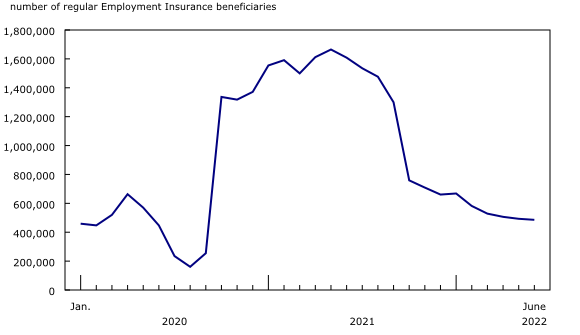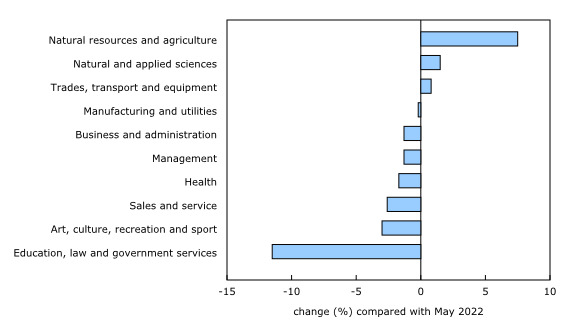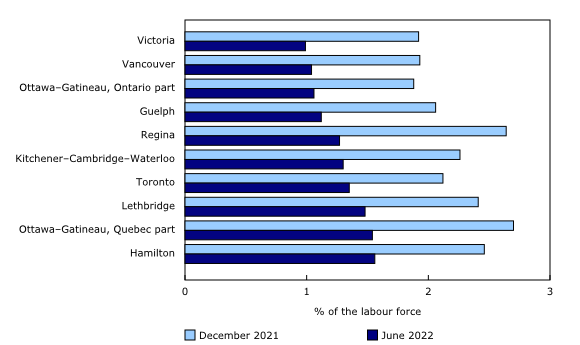Employment Insurance, June 2022
Released: 2022-08-18
In June, 486,000 Canadians received regular Employment Insurance (EI) benefits, down by 7,000 (-1.4%) from May.
According to the Labour Force Survey (LFS), unemployment fell by 54,000 (-5.1%) in June, resulting in a record low unemployment rate of 4.9%. Employment also fell in June (-43,000; -0.2%), and the participation rate—the share of the working age population who were either employed or unemployed—dropped 0.4 percentage points to 64.9%.
The number of regular Employment Insurance beneficiaries decreases in five provinces
Compared with May, the number of people who received regular EI benefits fell in five provinces in June. The largest proportional decrease occurred in Manitoba (-9.1%; -2,000) followed by Alberta (-3.9%; -2,000), Ontario (-2.3%; -3,000), British Columbia (-1.2%; -500) and Newfoundland and Labrador (-1.0%; -400). In contrast, the number of regular EI beneficiaries increased in Prince Edward Island (+2.2%; +200) and New Brunswick (+1.2%; +400).
On a regional basis, the census metropolitan areas (CMAs) of Hamilton (-13.1%; -1,000) and Winnipeg (-11.0%; -1,000) posted the largest proportional decreases in regular EI beneficiaries in June.
Fewer women in all age groups collected regular Employment Insurance benefits in June
The number of women receiving regular EI benefits fell by 7,000 (-3.2%) in June, accounting for almost all of the monthly decline. Most notably, there were 2,000 fewer (-10.2%) female EI recipients aged 15 to 24, mirroring LFS results which showed a drop in unemployment (-15,000; -13.1%) for this group. The number of EI beneficiaries also fell among core-age women (aged 25 to 54) (-2.8%; -3,000), and women aged 55 and older (-1.8%; -1,000).
At the same time, fewer male youth (-1.7%; -600) aged 15 to 24 received EI benefits in June. The number of EI beneficiaries was little changed among core-aged men (169,000), and men aged 55 and older (82,000).
The drop in regular Employment Insurance beneficiaries concentrated in education, law and social, community and government services occupations
The number of regular EI recipients declined in 6 of the 10 broad occupational groups in June, with the largest decrease occurring among those who last worked in occupations in education, law and social, community and government services (-11.5%; -7,000). Within this group, occupations in paraprofessional occupations in legal, social, community and education services (-18.6%; -3,000) and care providers and educational, legal and public protection support occupations (-15.1%; -4,000) accounted for nearly all of the monthly decline.
Compared with May, there was also a noticeable decline in EI beneficiaries who last worked in sales and service occupations (-2.6%; -2,000). In contrast, there were more regular EI recipients who last worked in natural resources, agriculture and related production occupations (+7.5%; +2,000) and natural and applied sciences and related occupations (+1.5%; +300).
Those who last worked in trades, transport and equipment operators and related occupations accounted for 31.4% of regular EI recipients in June, a larger proportion than any other broad occupational group. This group includes industrial, electrical and construction trades; and trades helpers, construction labourers and related occupations.
In the Spotlight: Regular Employment Insurance beneficiaries and regional labour shortages
During the first six months of 2022, labour market conditions in Canada grew increasingly tight. Although employment fell in June (-43,000; -0.2%), it rose by a cumulative total of 221,000 (+1.1%) in the first half of the year. Despite this strong employment growth, employers were seeking to fill just over 1 million (1,005,700) vacant positions at the beginning of May, highlighting months of persistently elevated levels of unmet labour demand.
In the context of this tightening, many employers may prefer to recruit workers with recent employment experience, including those receiving EI benefits. This pool of potential workers shrunk in the first half of 2022, as the number of regular EI beneficiaries declined 26.5% (-175,000 to 486,000), with British Columbia (-40.6%; -27,000), Alberta (-33.5%; -25,000) and Ontario (-30.7%; -59,000) seeing the largest proportional declines.
EI data also illustrate the extent to which labour markets have tightened at the local level during the first half of 2022. A number of CMAs saw a large drop in regular EI beneficiaries in the first half of the year, both in absolute terms and as a proportion of the total labour force. In the CMA of Victoria, British Columbia, for example, the number of beneficiaries dropped 44.9% (-1,700 to 2,100) and by June, 1.0% of the total labour force was a regular EI beneficiary (three-month moving average).
As the pool of workers with recent employment experience shrinks, some employers may focus on recruiting those who have not worked in the past 12 months, with their capacity to do so varying across CMAs. LFS data show that in the CMA of Toronto, those who had not worked in the past year made up a greater share of the unemployed in June than in the rest of the country (36.2% in the Toronto CMA, versus 30.6% in the rest of the country). Similarly, those who had never worked made up 19.2% of the unemployed in the Toronto CMA, compared with 13.4% elsewhere (three-month moving averages; not seasonally adjusted).
Sustainable Development Goals
On January 1, 2016, the world officially began implementing the 2030 Agenda for Sustainable Development—the United Nations' transformative plan of action that addresses urgent global challenges over the following 15 years. The plan is based on 17 specific sustainable development goals.
Employment Insurance statistics are an example of how Statistics Canada supports reporting on global sustainable development goals. This release will be used to help measure the following goal:

Note to readers
Employment Insurance in the context of broader COVID-19 benefit programs
No methodological changes have been made to the Employment Insurance Statistics (EIS) program over the COVID-19 pandemic period. EIS reflect the Employment Insurance (EI) program for the Labour Force Survey (LFS) reference week in each month.
Data for the October 2020 reference period and onward comprise individuals who obtained EI benefits and exclude beneficiaries of the Canada recovery benefits (Canada Recovery Benefit, Canada Recovery Caregiving Benefit, and Canada Recovery Sickness Benefit).
Concepts and methodology
The analysis focuses on people who received regular EI benefits related to job loss.
EI statistics are produced from administrative data sources provided by Service Canada and Employment and Social Development Canada. These statistics may, from time to time, be affected by changes to the Employment Insurance Act or administrative procedures.
EI statistics indicate the number of people who received EI benefits and should not be confused with LFS data, which provide estimates of the total number of unemployed people. There is always a certain proportion of unemployed people who do not qualify for benefits. Some unemployed people have not contributed to the program because they have not worked in the past 12 months or their employment was not insured. Other unemployed people have contributed to the program, but do not meet the eligibility criteria, such as workers who left their jobs voluntarily or those who did not accumulate enough hours of work to receive benefits.
All data in this release are seasonally adjusted, unless otherwise specified. To model the effects of the COVID-19 pandemic, values for all series from March 2020 to November 2021 have been treated with a combination of level shifts and outliers in determining a seasonal pattern for seasonal adjustment. For more information on seasonal adjustment, see Seasonally adjusted data – Frequently asked questions.
The number of regular EI beneficiaries for the current month and the previous month is subject to revision.
The number of beneficiaries is a measure of all people who received regular EI benefits from June 12 to 18, 2022. This period coincides with the reference week of the LFS.
Employment Insurance beneficiaries by industry
The industry of EI beneficiaries is determined by integrating EI data with record of employment administrative data. For beneficiaries with more than one record of employment in the 52 weeks prior to the reference week, the records with the greatest number of hours are used. If no industry information can be found, industry information is deemed "Not classified" for the beneficiary.
A census metropolitan area (CMA) or census agglomeration (CA) is formed by one or more adjacent municipalities centred on a population centre. A CMA must have a total population of at least 100,000. A CA must have a population of at least 10,000. See Standard Geographical Classification 2016 – Definitions for more information.
Data availability
In the data tables 14-10-0004, 14-10-0005, 14-10-0007 and 14-10-0008, for the March to September 2020 reference periods, data have been suppressed because a source data file contains records for Canada Emergency Response Benefit claimants and beneficiaries who could not be identified and excluded through processing.
Next release
Data on EI for July will be released on September 22.
Products
More information about the concepts and use of Employment Insurance statistics is available in the Guide to Employment Insurance Statistics (73-506-G).
Contact information
For more information, or to enquire about the concepts, methods or data quality of this release, contact us (toll-free 1-800-263-1136; 514-283-8300; infostats@statcan.gc.ca) or Media Relations (statcan.mediahotline-ligneinfomedias.statcan@statcan.gc.ca).
- Date modified:





